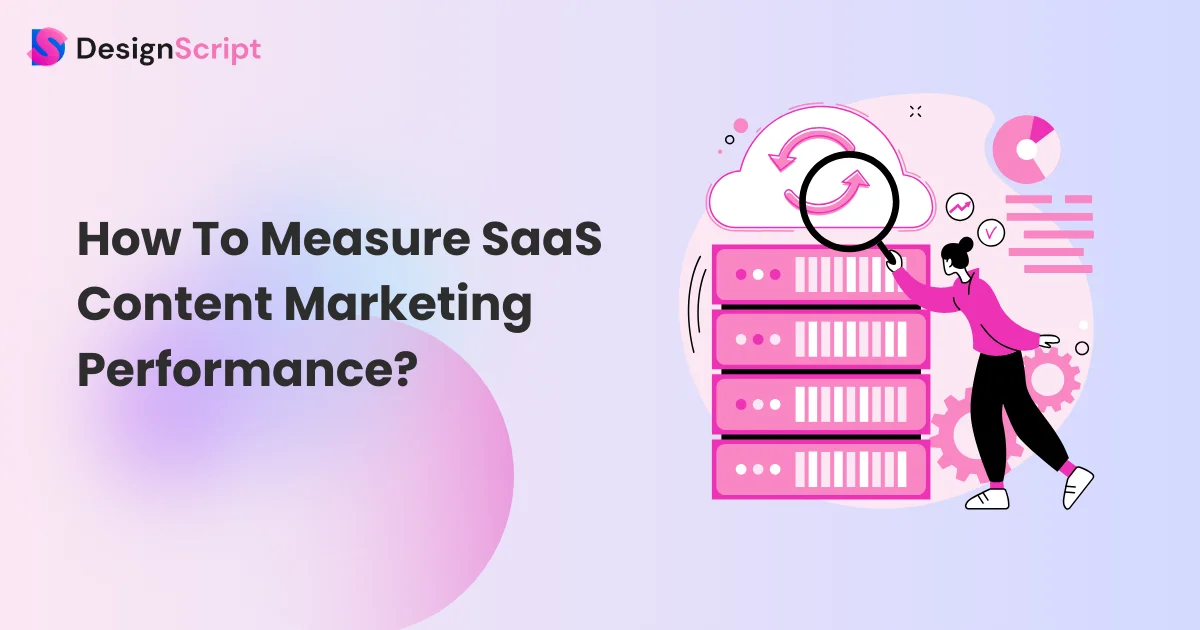How To Measure SaaS Content Marketing Performance?
A staggering 92% of marketers acknowledge the importance of content in the growth of their business. We all know that content marketing is one of the most crucial methods of enhancing brand visibility. However, in this dynamic landscape of marketing, to know whether or not a method is working, we need to measure it. Despite the importance measurement and analysis holds, many companies fail to quantify the impact of their SaaS content marketing performance. Well, if you don’t want to be a part of those 42% businesses, this article will delve deep into the intricacies of measuring Saas Content Marketing performance.
So join us and embark on the journey to unlock the limitless potential of your content marketing campaigns.
Table of Contents
- What is SaaS Content Marketing?
- Why Does Your SaaS Company Need to Measure Content Marketing performance?
- How to Measure SaaS Content Marketing?
- The Metrics Guiding Your B2B Content Strategy
- Content Marketing Metrics vs KPIs: What’s the Difference?
- Content Marketing Metrics and KPIs To Measure
- Organic Traffic
- Total blog views
- Total content published
- Top 10 performing posts
- Total number of keywords in the top 10
- Clickthrough Rate
- Content-Assisted Demos
- Bounce Rate
- Customer Acquisition Cost (CAC)
- Unique Visitors
- SERP Ranking
- Pages Per Session
- Average Time on Page
- Traffic Source
- Scroll Depth
- Metrics To Mastery!
- FAQs
What is SaaS Content Marketing?
SaaS Content marketing refers to the strategic use of content creation to attract, engage, and retain customers for software as a service (SaaS) businesses. It involves creation of information, interactive, engaging and entertaining content customized to the needs and wants of the targeted audience. The aim of SaaS marketing is to create awareness about brands, services, building relationships and hence conversions. Various forms of content marketing includes case studies, educational videos, blogs, whitepapers, eBooks, webinars and so much more. By providing your audience with these valuable insights and solving their problems, SaaS companies can establish trust and loyalty among its customers.
Why Does Your SaaS Company Need to Measure Content Marketing performance?

Measuring content marketing performance is crucial for SaaS companies. Why? You may ask. Well, let’s say you used 30% of your revenue and 50% of your human resources in content marketing every year. Despite your consistency and efforts you fail to generate conversions, now what is behind the slowdown? By measuring the SaaS content marketing performance. The key to successful business always lies in the ROIs they obtain from every campaign. This data helps you in decision-making by allowing companies to identify successful tactics, refine content strategies, and allocate resources more effectively. By consistently posting, evaluating and optimizing content performance, SaaS companies can enhance brand visibility, attract leads, nurture customers and drive revenue growth in a competitive market landscape.
How to Measure SaaS Content Marketing?
Measuring success in SaaS content marketing goes beyond just creating great content. It’s crucial to track key metrics to understand how your content performs and identify areas for improvement.
1. Set Clear Objectives

Setting clear objectives and goals is the very foundation of effective SaaS Content Marketing measurement. Clear objectives provides a roadmap for content strategy, guiding the creation and distribution of content towards achieving tangible outcomes. These objectives are often based on the lines of ‘SMART’ which stands for Specific, measurable, achievable, relevant and time-bound. Following this strategy, you can easily increase the website traffic by 20% within the span of 6 months or to generate 100 new leads per month. Without clear objectives, it becomes challenging to determine the success of the content creation efforts or to make decisions. It is important to know that without a map, a car might travel miles but the chances of driving in the right direction decreases significantly.
2. Evaluate Success Through (KPIs)

Key performance indicators (KPI) are one of the most crucial metrics for assessing the SaaS content marketing performance. These metrics help you track your growth and progress towards achieving your goals. Some of the most common KPI includes conversion rates, social media impressions, engagement, retention rates and revenue generated. Metrics are aligned with the objectives of the business hence it is crucial to regularly analyze and access them. By monitoring these KPIs, SaaS companies can make informed decisions regarding what strategies are working and what aren’t. It also helps in identifying the strengths and weaknesses of the business, optimization techniques and demonstration of impact of strategies to the stakeholders.
3. Use Analytics Tools

Leveraging analytics tools such as Google Analytics, Hubspot, or SEMrush you can generate a deep understanding of various aspects of SaaS content marketing performance. These tools are a great asset to track and analyze metrics such as website traffic, user demographics, engagement levels, conversion rates, and more. By leveraging data from analytics tools, SaaS companies can gain deeper understanding of audience behavior, identify trends, and measure the effectiveness of their content marketing inactivities. This data driven approach enables informed decision-making, optimization of content strategies and maximization of ROI.
4. Navigate Unique Visitors and Average Time Spent on Site

Monitoring metrics such as unique visitors and average time spent on site provides valuable insights into the effectiveness of SaaS content in attracting and engaging audiences. Let’s say a high number of unique visitors are visiting your website everyday and spending longer than average time going on the content, it signifies that the content you are creating is doing well and your target audience relates with it. Similarly, low engagement rates signify poor quality of content and hence improvement in the same. By analyzing these metrics, SaaS companies can optimize their content to enhance audience engagement and achieve their marketing objectives.
5. Check SEO and Organic Performance

Search engine optimization (SEO) is vital for improving the visibility and discoverability of SaaS content in search engine results. Monitoring SEO metrics such as keyword rankings, organic traffic, helps assess the impact of content on search engine ranking and organic performance. By optimizing content centric to keywords, improving site structure, and earning quality backlinks, SaaS companies can enhance their content’s visibility and attract organic traffic from search engines. Monitoring SEO performance enables companies to identify areas for improvement, optimize content strategies, and increase organic reach and traffic over time.
6. Perform A/B Testing

A/B testing refers to comparing two or more variations of content to determine which performs better in achieving desired objectives. Whether it comes to testing different headlines, call-to-action buttons, or imagery, A/B testing helps identify the most effective elements for driving engagement and conversions. With the help of experimentation, companies compare strategies and hence choose the best one that helps them optimize and improve audience engagement. A/B testing provides valuable insights into audience preferences and behaviors, enabling data-driven decision-making and continuous optimization of content marketing strategies.
7. Focus on ROI

Return on investment (ROI) determines the effectiveness of any campaign. Similarly, ROI of SaaS content marketing performance provides us with useful insights into the success of various strategies. ROI can easily be calculated by comparing the costs incurred with the revenue generated or other predetermined objectives, such as lead generation or customer acquisition. Focusing on return can help in allocating resources in an effective and efficient manner.
The Metrics Guiding Your B2B Content Strategy
In the competitive world of B2B marketing, content is king. But how do you know your content is reaching the right audience and driving results? Here’s where metrics come in. By tracking the right data points, you can refine your B2B content strategy to attract qualified leads and ultimately boost your business.
1. Consumption Metrics

Consumption Metric provides insights into how the audience is responding to your B2B content. These metrics are inclusive of, downloads, page views, time spent per page. While high page views indicate strong content visibility, downloads indicate the relevance of the content among your targeted audience. Average time spent on page reflects the engagement rates and effectiveness of the content for holding the attention of the audience. Analyzing consumption metrics gives a good picture of popular topics, formats, and channels, enabling businesses to customize the content for each customer. Moreover, understanding customer reactions helps optimize content distribution to reach and engage target audience more effectively.
2. Engagement Metrics

Engagement metrics measure how the audience interacts with your content. These metrics are indicated by likes, shares, comments, and social media engagement rates. High engagement rates refer to a high degree of content relevance while various participations indicate the interest of your audience in your content. By analyzing engagement metrics, marketers can assess the effectiveness of their content in capturing audience attention and fostering interactions. Moreover, these metrics offer an in-depth insight into the preferences and behaviors of the customers which in turn help markets improve their content. By consistently monitoring engagement metrics you can easily optimize your content and enhance the visibility and conversion.
3. Retention Metrics

Retention metrics refers to the ability of your business to retain audience overtime. These metrics include repeat visits, return visitors rates, and subscription renewals. High retention rates suggest that your content is valuable and relevant to your audience, encouraging them to return for more. By analyzing retention metrics, B2B marketers can assess the effectiveness of their content in maintaining audience interest and loyalty. Moreover, retention rates provide markets with an insight into the long-term impact of the content on audience engagement and brand affinity. These metrics alo help marketers analyze what their loyal customers are actively looking for.
4. Cost Metrics

Cost metrics evaluate the expenses associated with creating and distributing B2B content. These metrics include production costs, distribution costs,and cost per lead. By analyzing cost metrics, B2B marketers can assess the efficiency and profitability of their content marketing efforts. For example, comparing the cost per lead against the revenue generated from those leads can help determine the return on investment of content marketing strategy. These metrics are an excellent dive into the allocation of resources and thereby its distribution in an effective and efficient manner. By navigating through cost metrics, B2B marketers can maximize the effectiveness of their content marketing efforts while optimizing resource utilization to drive business growth and profitability.
5. Lead Generation Metrics

Lead generation metrics refers to the effectiveness of your B2B content in generating leads and conversions. These metrics include lead volume, lead quality, and conversion rates. High lead volume suggests strong content visibility and appeal to your target audience, while lead quality indicates the relevance and readiness of leads to convert into customers. Conversion rates are a direct reflection of effectiveness of your content to drive customers acquisition. By analyzing and understanding these metrics a marketer can understand what content leads to most conversions and hence escalate the growth and development of the same.
Content Marketing Metrics vs KPIs: What’s the Difference?
| Aspect | Content Marketing Metrics | Key Performance indicators (KPIs) |
| Focus | The focus here is specific data points measuring various aspects of content performance. | The focus in KPI is broader, strategic objectives aligned with overall business. |
| Examples | Various examples of content marketing metrics are on pages views, likes, shares, comments. | Examples of KPI include conversion rates, lead generation metrics, customer acquisition costs and return on investment. |
| Purpose | Content marketing provides insights into audience interactions with content and its impact on behavior. | KPI serves as benchmarks for assessing overall success and effectiveness of content marketing initiatives. |
| Usage | It is used to optimize content strategies, improve content quality, and identify2 areas for improvement. | It is used to evaluate performance and impact of content marketing efforts in driving business growth and achieving objectives. |
Content Marketing Metrics and KPIs To Measure

Creating great content is just the first step. To truly win with SaaS content marketing, you need to measure its impact. By tracking key metrics and KPIs (Key Performance Indicators), you’ll gain valuable insights to optimize your content and maximize your return on investment (ROI).
1. Organic Traffic
Organic traffic refers to visitors who land on your website through unpaid search engine results. It is an important metric for assessing SEO performance and content visibility in search engines, reflecting the success of your website in attracting visitors through search results.
2. Total blog views
Total vlog views refers to the cumulative number of views across all blog posts on your websites. The metrics offer an insight into overall popularity and relevance of your blog content, indicating which topics resonate most with your audience.
3. Total content published
Total content published is simply the quantity of content created and published within a specific period of time. This metric demonstrates the consistency and output of your content creation efforts, helping you track your content production schedule and evaluate your content marketing strategy.
4. Top 10 performing posts
The top 10 performing posts refers to the most successful content pieces in SaaS marketing. These posts are decided on the basis of metrics such as rate, unique visitors, and average time on page. These posts help gauge keywords effectively and audience engagement, and conversion potential, informing strategies to optimize content, reduce bounce rate, and lower customer acquisition costs.
5. Total number of keywords in the top 10
The cumulative count of keywords present in the top performing posts are referred to as top keywords and it indicates the diversity and relevance of keyword driving traffic to desired destination.
6. Clickthrough Rate
The percentage of users who click on a link in SaaS content is referred to as click through rate. It measures the effectiveness in generating interest and driving traffic to desired destinations.
7. Content-Assisted Demos
Content assisted demos refers to showcasing product features and benefits to the potential customers. This facilitates the conversion of leads into demos or trials and ultimately secured clients.
8. Bounce Rate
The percentage of visitors who navigate away from a SaaS website after viewing only one piece of content or page, indicating the effectiveness of content in retaining user interest and encouraging further exploration.
9. Customer Acquisition Cost (CAC)
The average cost of acquiring a new customer through SaaS content marketing is called CAC. These metrics are calculated considering factors such as advertising spend, content creation, and conversion optimization.
10. Unique Visitors
The count of unique individuals who visit the site or content within a specific time frame refers to unique visitors. These metrics indicate the reach and appeal of the marketing efforts.
11. SERP Ranking
Search engine result pages (SERP) refers to influencing visibility and organic traffic, with higher rankings relating to increased click throughs and conversions.
12. Pages Per Session
Pages per session is the number of pages a visitor viewed in a single session. This reflects the depth of engagement and the effectiveness of the content in encouraging exploration.
13. Average Time on Page
The average time spent on a SaaS content page, indicating user interest and engagement levels, with longer times suggesting deeper engagement and potential conversion readiness.
14. Traffic Source
The origin of all the visitors refers to the traffic source. This traffic is categorized into channels such as organic search, referral, social media, informing strategies to optimize high-performing channels and diversity traffic sources.
15. Scroll Depth
The measure of how far users actually scroll down a page refers to scroll depth. The deeper they scroll better the engagement rates and interest of the targeted audience.
Metrics To Mastery!
At the end of the day, creating amazing content is just the first step in your SaaS marketing journey. To truly thrive, you need to measure how that content is performing. By zeroing in on key metrics like engagement, conversion rates, and ROI, you can unlock insights that help you understand what’s working and what needs a little love.
Keep an eye on unique visitors, pages per session, and average time on page. These metrics reveal how well your content is resonating with your audience. Regularly checking in and tweaking your approach based on what the data tells you will empower you to adapt and optimize your strategies.
So, are you ready to elevate your SaaS content marketing?
Start tracking those metrics and see how they can transform your efforts! If you’d like some expert advice or a fresh perspective, don’t hesitate to reach out.
Let’s unlock your content’s full potential together!
FAQs
Monitor key metrics like website traffic, engagement (time on page, clicks), and conversions (leads, signups). This shows if your content is attracting and converting readers.
Align KPIs with goals (brand awareness, lead gen). Track metrics relevant to each goal (e.g., organic traffic for brand awareness, conversion rates for lead gen).
– Organic traffic: Website visitors from search engines.
– Engagement: Time spent on content, clicks, shares.
– Leads: Captured contact info for potential customers.
– Conversions: Visitors taking desired actions (signups, demos).
– Customer acquisition cost (CAC): Cost to acquire a customer.
– Return on investment (ROI): Revenue generated from content.
It’s best to review your metrics regularly, monthly or quarterly, to identify trends and make timely adjustments. This way, you can stay agile and ensure your strategies are effectively driving results.
Tools like Google Analytics, HubSpot, and SEMrush are great for tracking performance. They provide insights into traffic, engagement, and conversions, helping you make data-driven decisions to optimize your content strategy.

